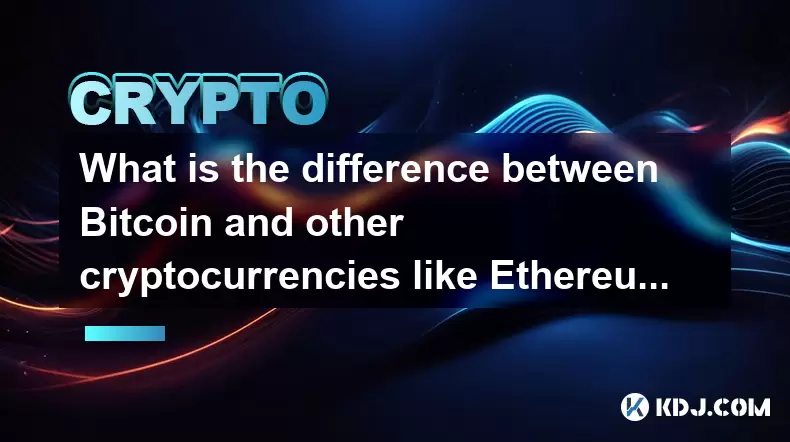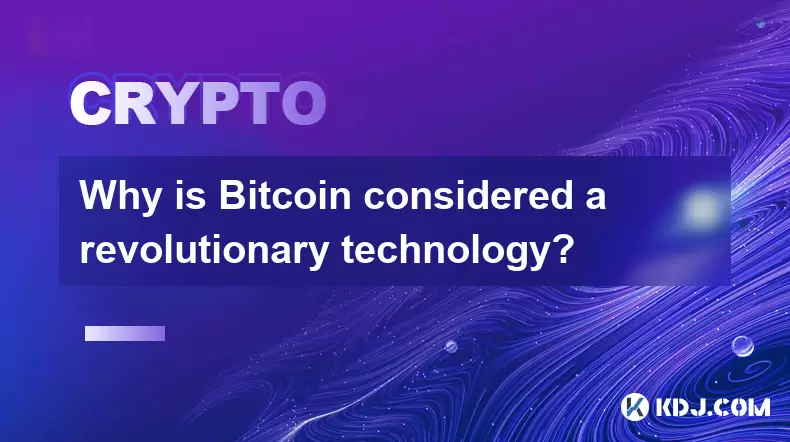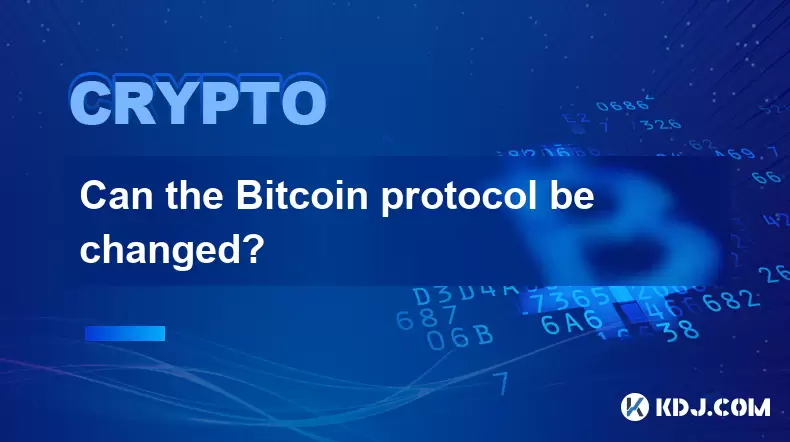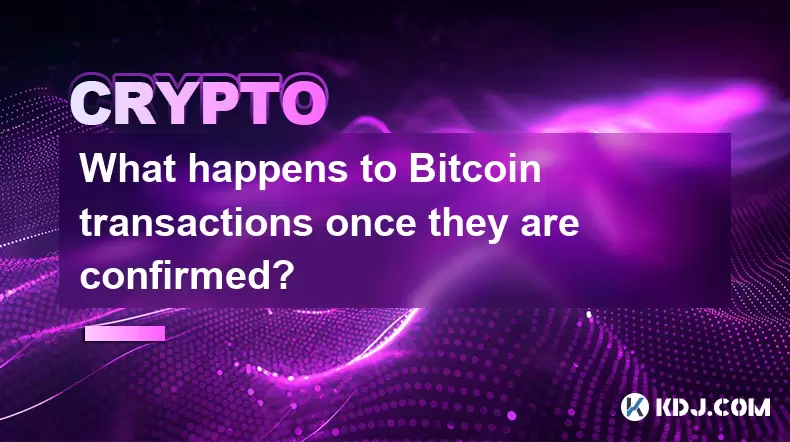-
 bitcoin
bitcoin $123963.239194 USD
1.37% -
 ethereum
ethereum $4529.082464 USD
1.07% -
 xrp
xrp $2.983640 USD
0.71% -
 tether
tether $1.000287 USD
0.02% -
 bnb
bnb $1179.874393 USD
2.99% -
 solana
solana $230.633678 USD
1.55% -
 usd-coin
usd-coin $0.999835 USD
0.03% -
 dogecoin
dogecoin $0.254240 USD
1.34% -
 tron
tron $0.341176 USD
0.15% -
 cardano
cardano $0.842285 USD
0.52% -
 hyperliquid
hyperliquid $48.537896 USD
-0.86% -
 chainlink
chainlink $21.863092 USD
-0.84% -
 ethena-usde
ethena-usde $0.999743 USD
-0.07% -
 sui
sui $3.579561 USD
-0.18% -
 stellar
stellar $0.403418 USD
2.67%
What is the difference between Bitcoin and other cryptocurrencies like Ethereum?
Bitcoin is a decentralized digital currency focused on secure, borderless transactions, while Ethereum is a platform for smart contracts and decentralized apps.
Aug 09, 2025 at 08:07 pm

Understanding the Core Purpose of Bitcoin
The primary function of Bitcoin is to serve as a decentralized digital currency. Designed by Satoshi Nakamoto in 2009, Bitcoin was introduced as a peer-to-peer electronic cash system. Its main goal is to enable secure, transparent, and borderless transactions without the need for intermediaries like banks or governments. The underlying technology, known as the Bitcoin blockchain, records every transaction in a public ledger that is maintained by a network of nodes around the world. This ledger is secured through proof-of-work (PoW) consensus, where miners solve complex mathematical puzzles to validate transactions and add new blocks. The total supply of Bitcoin is capped at 21 million coins, which introduces scarcity and is a key reason many view it as digital gold.
Exploring Ethereum’s Broader Functionality
Unlike Bitcoin, Ethereum was created not just as a currency but as a platform for decentralized applications (dApps). Proposed by Vitalik Buterin in 2013 and launched in 2015, Ethereum introduced the concept of smart contracts—self-executing agreements written in code that automatically run when predefined conditions are met. These contracts are stored and executed on the Ethereum Virtual Machine (EVM), which allows developers to build applications ranging from decentralized finance (DeFi) platforms to non-fungible tokens (NFTs). Ethereum also uses a blockchain, but its design supports more complex operations than Bitcoin’s. While Ethereum originally used proof-of-work, it transitioned to proof-of-stake (PoS) in 2022 during The Merge, significantly reducing energy consumption and changing how validators are selected.
Differences in Consensus Mechanisms and Network Security
Bitcoin relies on proof-of-work, requiring miners to use computational power to solve cryptographic puzzles. This process secures the network and ensures that no single entity can control the blockchain. Miners are rewarded with newly minted BTC and transaction fees. In contrast, Ethereum now uses proof-of-stake, where validators must stake 32 ETH to participate in block creation and validation. This shift reduces the environmental impact and lowers the barrier to entry for securing the network. Validators are chosen based on the amount of ETH they hold and are willing to lock up as collateral. If they act maliciously, their stake can be slashed. This change has made Ethereum’s consensus more energy-efficient and scalable, although Bitcoin’s PoW remains one of the most battle-tested security models in the crypto space.
Transaction Speed and Scalability Features
Bitcoin processes approximately 7 transactions per second (TPS), with block times averaging 10 minutes. This limitation stems from its conservative approach to security and decentralization. Increasing block size or frequency could compromise node participation due to higher hardware demands. Ethereum, on the other hand, handles between 15 to 30 TPS under normal conditions, with block times as short as 12 to 14 seconds. Ethereum has implemented various upgrades to improve scalability, such as EIP-1559, which changed fee mechanics, and is actively developing sharding and rollups to further increase throughput. These layer-2 solutions allow transactions to be processed off the main chain and later settled on it, reducing congestion and fees.
Programming Capabilities and Ecosystem Development
Bitcoin’s scripting language is intentionally limited and not Turing-complete, meaning it cannot support complex logic or applications. This restriction enhances security by minimizing vulnerabilities. Developers cannot deploy smart contracts directly on Bitcoin, although projects like Stacks and Rootstock aim to add smart contract functionality on top of it. Ethereum, however, uses Solidity and other Turing-complete languages, enabling developers to create virtually any type of decentralized application. This flexibility has led to the rapid growth of an ecosystem including decentralized exchanges (DEXs) like Uniswap, lending platforms like Aave, and NFT marketplaces like OpenSea. The ERC-20 and ERC-721 token standards on Ethereum have become foundational for issuing new tokens and digital assets.
Economic Models and Token Supply Dynamics
Bitcoin has a fixed supply of 21 million coins, with new coins released through block rewards that halve approximately every four years in an event known as the halving. This deflationary model is designed to mimic scarcity, similar to precious metals. Ethereum does not have a hard cap on supply, though issuance has decreased significantly after transitioning to PoS. Instead, Ethereum implements a burning mechanism where a portion of transaction fees is permanently removed from circulation, potentially making it deflationary during periods of high network usage. The economic model of Ethereum is more dynamic, adapting to network demand and usage patterns, while Bitcoin’s model emphasizes predictability and long-term value preservation.
Frequently Asked Questions
Can Ethereum be used as a store of value like Bitcoin?While Bitcoin is widely recognized as a digital store of value due to its scarcity and first-mover status, Ethereum serves multiple roles. It functions as both a currency and a utility token required to pay for transactions and smart contract execution (known as gas fees). Some investors do hold ETH as a long-term asset, especially given its central role in DeFi and NFTs, but its value is more closely tied to network activity than pure scarcity.
Is Bitcoin programmable like Ethereum?Bitcoin’s scripting system is not programmable in the same way as Ethereum. It lacks support for complex smart contracts. However, newer protocols built on top of Bitcoin, such as the Lightning Network for fast payments or Ordinals for inscribing data, extend its functionality without altering the base layer. These are external solutions, not native programming capabilities.
Why did Ethereum switch from proof-of-work to proof-of-stake?Ethereum transitioned to proof-of-stake to improve scalability, security, and sustainability. PoS consumes significantly less energy, reduces centralization risks associated with mining pools, and allows for faster implementation of future upgrades like sharding. The change was executed through a process called The Merge, which combined the original Ethereum mainnet with the Beacon Chain, the PoS coordination layer.
Do Bitcoin and Ethereum compete with each other?They serve different primary purposes. Bitcoin is optimized for value transfer and storage, while Ethereum focuses on decentralized computation and application hosting. Many investors and institutions hold both, viewing them as complementary rather than direct competitors. Their coexistence supports a broader cryptocurrency ecosystem with distinct use cases.
Disclaimer:info@kdj.com
The information provided is not trading advice. kdj.com does not assume any responsibility for any investments made based on the information provided in this article. Cryptocurrencies are highly volatile and it is highly recommended that you invest with caution after thorough research!
If you believe that the content used on this website infringes your copyright, please contact us immediately (info@kdj.com) and we will delete it promptly.
- BlockDAG, DOGE, HYPE Sponsorship: Crypto Trends Shaping 2025
- 2025-10-01 00:25:13
- Deutsche Börse and Circle: A StableCoin Adoption Powerhouse in Europe
- 2025-10-01 00:25:13
- BlockDAG's Presale Buzz: Is It the Crypto to Watch in October 2025?
- 2025-10-01 00:30:13
- Bitcoin, Crypto, and IQ: When Genius Meets Digital Gold?
- 2025-10-01 00:30:13
- Stablecoins, American Innovation, and Wallet Tokens: The Next Frontier
- 2025-10-01 00:35:12
- NBU, Coins, and Crypto in Ukraine: A New Yorker's Take
- 2025-10-01 00:45:14
Related knowledge

Why is Bitcoin considered a revolutionary technology?
Aug 12,2025 at 08:29pm
Decentralization and the Elimination of Central AuthoritiesThe core innovation behind Bitcoin lies in its decentralized architecture, which fundamenta...

Why is Bitcoin considered a revolutionary technology?
Aug 10,2025 at 07:42pm
Decentralized Architecture and Trustless TransactionsBitcoin is considered revolutionary because it introduced a decentralized architecture that opera...

What are the key features of Bitcoin?
Aug 10,2025 at 02:50am
Decentralization and Peer-to-Peer NetworkOne of the most defining characteristics of Bitcoin is its decentralized nature. Unlike traditional financial...

Can the Bitcoin protocol be changed?
Aug 07,2025 at 01:16pm
Understanding the Bitcoin ProtocolThe Bitcoin protocol is the foundational set of rules that govern how the Bitcoin network operates. It defines every...

Can the Bitcoin protocol be changed?
Aug 11,2025 at 01:01am
Understanding the Bitcoin Protocol StructureThe Bitcoin protocol is the foundational set of rules that govern how the Bitcoin network operates. These ...

What happens to Bitcoin transactions once they are confirmed?
Aug 09,2025 at 05:22am
Understanding Bitcoin Transaction ConfirmationWhen a Bitcoin transaction is initiated, it is broadcast to the network and placed in a pool of unconfir...

Why is Bitcoin considered a revolutionary technology?
Aug 12,2025 at 08:29pm
Decentralization and the Elimination of Central AuthoritiesThe core innovation behind Bitcoin lies in its decentralized architecture, which fundamenta...

Why is Bitcoin considered a revolutionary technology?
Aug 10,2025 at 07:42pm
Decentralized Architecture and Trustless TransactionsBitcoin is considered revolutionary because it introduced a decentralized architecture that opera...

What are the key features of Bitcoin?
Aug 10,2025 at 02:50am
Decentralization and Peer-to-Peer NetworkOne of the most defining characteristics of Bitcoin is its decentralized nature. Unlike traditional financial...

Can the Bitcoin protocol be changed?
Aug 07,2025 at 01:16pm
Understanding the Bitcoin ProtocolThe Bitcoin protocol is the foundational set of rules that govern how the Bitcoin network operates. It defines every...

Can the Bitcoin protocol be changed?
Aug 11,2025 at 01:01am
Understanding the Bitcoin Protocol StructureThe Bitcoin protocol is the foundational set of rules that govern how the Bitcoin network operates. These ...

What happens to Bitcoin transactions once they are confirmed?
Aug 09,2025 at 05:22am
Understanding Bitcoin Transaction ConfirmationWhen a Bitcoin transaction is initiated, it is broadcast to the network and placed in a pool of unconfir...
See all articles










































































